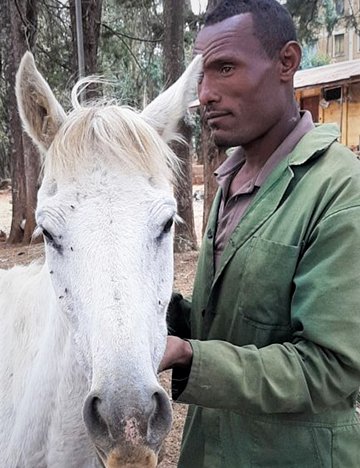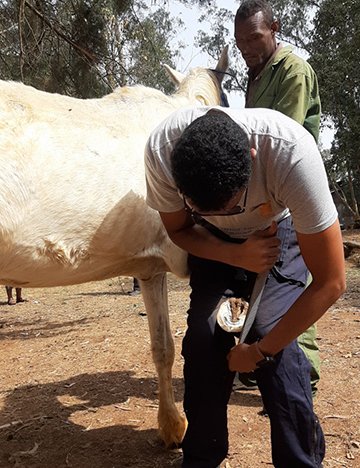A Second Chance at Life
Brooke Ethiopia's Shahida Hussein recounts this life-affirming story of a gharry horse called Molalign.

For the last five years he was the backbone of the family. He runs here and there making some daily money, bringing something to the table. As long as he is there they are fine: at least daily bread is not that problematic. As he is the major income source and satisfies their basic need they call him Molalign (meaning the one who fulfills and satisfies one's need).
Tesfaw Andualem, caretaker and owner of Molalign, is a father of three and lives in Debre Markos, a town in the Amhara region around 300 km from Addis Ababa. He says, "Molalign was my everything". Suddenly one morning Molalign was lame and could not pull the gharry (a people-carrying cab) as usual, leading to shockwaves in the family.
Though he was taken to the local clinic for treatment and relief, his conditions worsened from day to day due to a hoof abscess and awful pus oozing from his front right hoof.
The condition was beyond the local provider’s capacity, and as Tesfaw thought he wouldn’t survive the wound he decided to take good care of him until his final days.
As their major income source, when he fell sick they felt the impact very badly. They had to face the bitter truth of life without Molalign’s help.

Tesfaw was forced to borrow some money from the bank to purchase a replacement horse, and their livelihood started reviving a little. Yet it was not enough to provide for all the family.
As Tesfaw and his family have a special attachment with Molalign they kept him safe for quite some time. The size of the house was too small to host two horses alongside the family. Given the limited income and family size, they realised that they couldn’t afford to take care of Molalign any longer. Eventually they had to make the hardest decision, and they were forced to abandon Molalign. “It was the hardest thing to do. We were all emotional on that day,” said Tesfaw.
Watching the physically challenged Molalign on the street suffering was the hardest feeling. As no one was there to take care of him his condition was getting worse and even more complicated as time wore on. The prolonged suffering was painful for Tesfaw to witness.
“I couldn't stand to watch him suffer every day. I wished for him to have a peaceful sleep and not to wake up,” said Tesfaw, broken-hearted and tearing. Meanwhile the Brooke Ethiopia team was in Debre Markos conducting capacity-building training. Local gharry owners were among the trainees catching up on equine best treatment skills. Many horses with serious physical conditions were treated on the spot, and luckily the abandoned Molalign was one of them. He was given pain relievers, his hoof abscess well-drained, flushed, and bandaged with five days follow-up treatment by the team.
According to Dr. Gebeyehhu Dilnesaw (BE staff), Molalign’s sole was drilled over by an unknown object and developed infection through time. It took only a week for Molalgine to touch the ground once again.
Three months after the treatment, Ato Tesfaw came to the BE office to report the health condition of Molalign. He said, ‘’Molalign is completely recovered. Now he is back to business and strong as before. Now we are using the two horses in a shift.”
The abandoned horse on death row miraculously got a second chance. Molalign has rejoined his family, as he gains his strength back and he is serving them well. As a result, their quality of life has changed for the better, and due to the training Tesfaw knows how to take good care of his equines. For both parties, this appears as a win-win solution. Tesfaw expressed his heartfelt gratitude to Brooke, saying "your intervention has had a direct impact on our life. Thanks to the training we know how to take care of our equines and clean hooves regularly to avoid similar conditions".
